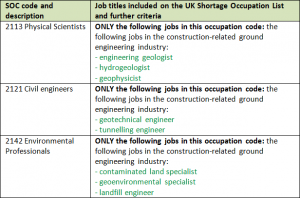
Article written by Tom Phillips, RPA Safety Services and Julian Lovell, Chair of AGS Safety Working Group and Managing Director of Equipe.
CDM2015 came into effect on the 6th of April 2015 and duty holders within the geotechnical sector are starting to grapple with the reality of implementation. With an increased emphasis on Client responsibilities, in an industry sector where the Client is rarely directly involved in the ground investigation phase, questions about how the regulations will be applied are being asked.
In conversation with the Health and Safety Executive, Tom Phillips of RPA Safety Services and Julian Lovell, Managing Director of Equipe and Chair of the AGS Safety Working Group attempt to clarify some of the questions consultants and contractors are raising.
Q. The definition of ‘construction’ in regulation 1, excludes site survey and in many cases our clients see ground investigation as site survey. Could you clarify the limits of site survey?
Site survey is restricted to non-intrusive works so taking levels, making measurements, site walkovers, gas monitoring and visually examining structures for faults would all be typical examples. If the works involve penetrative works, even with hand tools, the work is classed as construction and the regulations apply.
We are keen to stress though, that the regulations should be applied proportionally to the level of risk involved. A shallow, hand dug trial hole will require minimal paperwork in terms of a construction phase plan, as the risk is low, but duty holders will still need to consider the risks associated with such things as underground services, contaminants, ground stability, preventing falls into the excavation and they must plan how the work will be carried out, kept safe and made good. In many cases, simple repetitive work will be based on standard company procedures but these will need tailoring for the site and locality in question and the prevailing conditions.
Q. Consultants and contractors are finding it difficult to get clients to accept and fulfil their duties under regulation 15 (1), which states: ‘A contractor must not carry out construction work in relation to a project unless satisfied that the client is aware of the duties owed by the client under these Regulations.’ In many cases they are not employed directly by the client and have no contact with them at all.
To what extent does this prevent contractors from starting work and will they be held liable for client’s failures to make the correct appointments and satisfy their duties?
The regulations do not prevent geotechnical contractors working, even if the client has not fully complied with their duties. Key for the contractor, is to ensure they have made the client aware of the client’s duties under CDM. This can be done as part of the tendering process, or following appointment.
In such instances, the contractor still needs to make wider arrangements to manage the site for the duration of their attendance (appropriate to the role they are carrying out) despite a lack of formal appointment.
The contractor should therefore ensure the site is secure, ensure suitable welfare arrangements are in place and comply fully with their part 4 duties under the regulations. They should also prepare (or contribute to an existing) Construction Phase Plan which will deal with how they intend to arrange the work and how they will manage foreseeable hazards both at and adjacent to the site.
The construction phase plan should also identify any additional information that the contractor needs before starting work. If the client is not able to provide that information (e.g. services location, intrusive asbestos survey, ordnance assessment, etc.) then the contractor should arrange with the client for the work to be carried out as a separate part of the contractor’s contract.
Where the contractor is the main contractor on all or part of the site they should manage all work in the area they are responsible for unless a principal contractor is appointed and active. Where the contractor carries out design work (e.g. temporary works including perimeter fencing, arranging traffic management routes, ground conditions assessment and alterations, excavation support arrangements, etc.) they should ensure they follow the principle of avoid the hazard or use a suitable control measure to minimise risk.
Q. When a geotechnical contractor is appointed as Principal Contractor (PC) or Principal Designer (PD), in the early stages of a GI phase, or they pick up those duties by default, is there a danger they could be deemed PC and PD for subsequent phases?
Absolutely. Without clear arrangements to the contrary, there is every danger that a geotechnical contractor could be assumed to be responsible for following phases of works. It is therefore important that where a geotechnical contractor is appointed, or by default is expected to carry out the duties of the Principal Contractor and Principal Designer (a requirement on any project where there is likely to be more than one contractor), they clearly limit their role to their phase of works only. This will include limiting the Construction Phase Plan to the geotechnical phase. Where the existing contract paperwork is not clear on this issue the contractor should write to their client to confirm the extent of the contractor’s role.
Q. Regulation 2 defines a contractor as ‘any person (including a non-domestic client) who, in the course or furtherance of a business, carries out, manages or controls construction work’. Does this definition mean consultants may be classed as contractors?
The duty holder ‘contractor’ relates to those who: determine the manner in which the work is being done (this may also include a design element so they may hold dual roles), provide supervision or engage other contractors. This can include ‘consultancies’ in many instances.
As an example, where a consultant engages a drilling contractor and determines the nature and type of works or supplies supervision, they would both be deemed contractors and it will be the consultancy’s responsibility to ensure the client is aware of their duties. The client would then need to make the necessary appointments. Where a domestic client is involved, the consultancy (as a contractor) may be deemed to be principal contractor and principal designer by default, even if the client fails to make formal appointments. Where a commercial client is involved, any failure to appoint will result in the client carrying the role of principal designer and/or principal contractor.
Further reading:
HSE Publication L153 – Managing health and safety in construction – Construction (Design and Management) Regulations 2015 – http://www.hse.gov.uk/pubns/books/l153.htm
CITB Guidance on CDM – http://www.citb.co.uk/health-safety-and-other-topics/health-safety/construction-design-and-management-regulations/cdm-guidance-documents/


